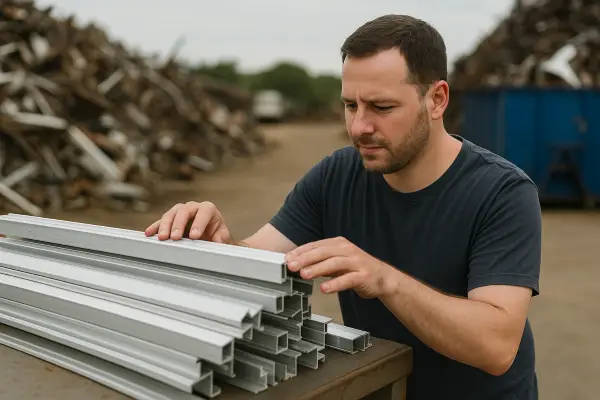Understanding what constitutes clean scrap metal is fundamental for anyone serious about maximizing recycling profits and streamlining operations. The distinction between clean and contaminated material can mean the difference between premium pricing and significantly reduced payouts at the scrap yard. So what is clean scrap metal?
During my early days working with industrial fabrication waste, I learned this lesson the hard way when a supposedly valuable copper batch was downgraded to mixed metal pricing due to steel wire attachments I’d overlooked. That experience taught me the critical importance of proper material assessment and preparation.
What is clean scrap metal?
Clean scrap metal refers to metal materials that are free from contaminants, attachments, and foreign substances that would interfere with the recycling process or reduce the metal’s purity. This means the metal contains no paint, plastic, rubber, dirt, oil, or other non-metallic materials that require removal before processing.
The recycling industry maintains strict standards for what qualifies as “clean” because contaminants must be removed during processing, which adds cost and reduces efficiency for steel mills and other processors. Clean scrap commands premium prices because it can move directly to melting and purification with minimal preprocessing.

Characteristics of clean scrap metal
Clean scrap metal exhibits several key characteristics that distinguish it from contaminated or “dirty” scrap. The material must be readily identifiable as a specific metal type without extensive testing or separation procedures.
For copper, clean scrap includes bare bright copper wire free of attachments, uncoated copper pipe, and bus bars without solder or tin coating. The copper should display its characteristic reddish color without oxidation or surface treatments that mask its composition.
Aluminum qualifies as clean when it contains no steel components, rubber attachments, or plastic fittings. Clean aluminum includes extruded shapes like channels and tubing, casted aluminum without steel inserts, and thin aluminum sheeting free from iron, plastic, or glass attachments.
Steel and iron reach clean status when they’re free from excessive rust, paint, or non-ferrous attachments. The material should be easily identifiable as ferrous metal through magnetic testing and visual inspection.
Standards for different metal types
Each metal category has specific cleanliness requirements that reflect processing capabilities and market demands. Non-ferrous metals typically command higher prices for clean material because they’re more valuable and sensitive to contamination.
Clean brass must be free from iron, steel, or other metal attachments, while dirty brass contains these contaminants and typically sells for about half the price of clean brass. The difference in value reflects the additional processing required to separate mixed materials.
Stainless steel cleanliness standards focus on magnetic properties and size restrictions. Clean stainless steel must be non-magnetic (300 series), indicating higher nickel content, and meet size limitations for efficient processing.
Lead requires special attention due to its toxic properties. Clean lead must be separated from steel clips, dirt, and other contamination while following proper safety protocols during handling and transportation.
Contamination factors that reduce value
Several contamination factors can downgrade clean scrap to lower-value categories, significantly impacting pricing and marketability. Understanding these factors helps recyclers maintain material quality throughout collection and processing.
Physical attachments represent the most common contamination source. Steel screws in aluminum, plastic fittings on copper pipe, and rubber components on metal assemblies all reduce material grade and pricing. These attachments require mechanical separation before processing, adding cost and complexity.
Surface contamination from paint, oil, grease, or chemical residues can disqualify otherwise clean metal. Scrap yards must clean metal to remove paint, solvents, and other contaminants before recycling, which reduces efficiency and profitability.
Mixed metal contamination poses particular challenges because different metals have incompatible melting points and chemical properties. Copper mixed with aluminum creates processing difficulties that require specialized separation techniques.
Economic impact of cleanliness standards
The economic implications of clean versus contaminated scrap extend throughout the recycling supply chain, affecting everyone from individual scrappers to large-scale processors. Dirty brass typically sells for approximately $0.60 per pound compared to clean brass at $1.40 per pound, demonstrating the significant price differential.
Processing facilities prefer clean scrap because it reduces operational costs and improves furnace efficiency. Clean metal requires less energy for purification and produces higher-quality recycled material suitable for demanding applications.
Market dynamics favor clean scrap because manufacturers can rely on consistent quality for their production processes. This reliability translates to stable pricing and strong demand for properly prepared materials.
Conclusion
Clean scrap metal represents the gold standard in recycling operations, commanding premium prices while supporting efficient processing and high-quality end products. The investment in proper sorting, cleaning, and preparation pays dividends through enhanced material value and stronger business relationships.
Just last January, I helped a local contractor establish cleaning protocols for demolition debris, focusing on copper piping separation and aluminum window frame preparation. Within three weeks, his average per-pound pricing increased by 40% simply through improved material cleanliness standards. These results demonstrate that understanding and implementing clean scrap practices transforms recycling from a disposal necessity into a genuine profit center.
